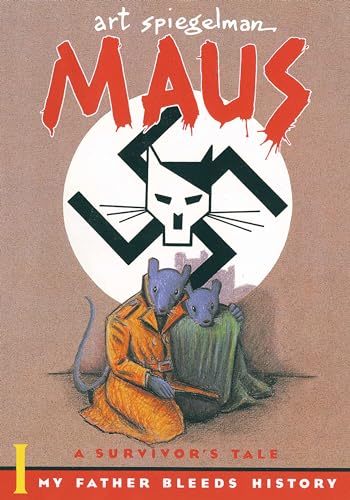Hey there, book enthusiasts! Today’s review is all about Art Spiegelman’s Maus. This graphic novel blends history, personal trauma, and captivating storytelling. It uses a clever mix of animal characters to depict different races and takes readers through a powerful narrative of the Holocaust. With stark black-and-white art, Spiegelman masterfully contrasts past and present, making Maus a monumental work in the graphic novel genre. Buckle up, folks, this one’s a rollercoaster of emotions!
In a Nutshell
Maus by Art Spiegelman is a graphic novel like no other. It’s a mix of autobiography, biography, and history, all rolled into one. Spiegelman tells the story of his father, Vladek, a Jewish Holocaust survivor. The tale is told through interviews between Art and Vladek, jumping back and forth between the past and the present.
One of the most unique features of the book is its use of animals to represent different races and nationalities. Jews are depicted as mice, Germans as cats, and Poles as pigs. This, alongside the stark black-and-white art, brings a raw and honest portrayal of the horrors of the Holocaust.
Themes in Maus aren’t light. They include trauma, survival, guilt, and the relationship between father and son. Despite the heavy subject, Spiegelman adds touches of humor, making the story not just bearable, but deeply engaging.
Maus is not just a story about the Holocaust; it’s a story about memory and how it shapes us. It’s a powerful read that has left a big mark on the graphic novel genre. Grab some tissues; this one hits hard.
Art Spiegelman’s Unique Storytelling Approach in Maus
Art Spiegelman’s Maus is no ordinary comic book. It’s a gripping tale that blends raw history with personal trauma. Spiegelman’s approach is both brilliant and simple, making the heavy subject more accessible.
Spiegelman uses animals to represent different races and nationalities. Jews are mice, Germans are cats, and so on. This choice might seem odd, but it makes the atrocities of the Holocaust both more bearable to read and more stark. It’s like watching a Tom and Jerry cartoon, but with very high stakes. You can almost hear the somber violin playing in the background.
He keeps the narrative tight and personal by focusing on his father, Vladek Spiegelman. By sharing Vladek’s story, he adds depth and emotion. It’s not just history; it becomes a family saga. At times, you feel like you’re sitting at the Spiegelmans’ dinner table, listening to Vladek’s stories yourself. I once tried to tell my friend’s grandpa’s war stories at a party. Let’s just say, it didn’t go quite as well!
Spiegelman’s art style is black and white, which fits the mood perfectly. It’s stark, dramatic, and leaves nothing to the imagination. There’s no room for distractions. Just raw, unfiltered emotion. The way he balances dialogue and visuals is exceptional. Every panel contributes to the overall story, much like every brick in a wall.
If you’ve ever tried reading it on a crowded bus, you’ll notice people peeking over your shoulder. It’s that engaging. And trust me, I’ve had to jostle for elbow room more than once.
Now, let’s move on to how Spiegelman juxtaposes the past and present in his epic tale.
Juxtaposition of Past and Present in ‘Maus’
Art Spiegelman creates a unique blend of past and present in his graphic novel Maus. His father, Vladek Spiegelman, tells his harrowing tale of surviving the Holocaust. We see the contrast between Vladek’s past and the present-day chapters where Art interviews his father. This shift between timelines adds depth to the story.
Maus is not just about history. It’s a story about how history affects future generations. Art’s strained relationship with his father is evident. The past horrors haunt Vladek, making him a difficult man to connect with. This dynamic is familiar to many families with trauma, making the story relatable.
We also see how the past has shaped Vladek’s personality. His resourcefulness in the concentration camps is shown alongside his stinginess in the present. This contrast makes you think about how extreme experiences change people. The past and present intertwined show the lasting impact of trauma. This is a powerful narrative device that keeps the reader engaged.
The artwork also reflects this juxtaposition. The stark black-and-white illustrations emphasize the bleakness of Vladek’s past. Meanwhile, the more detailed present-day drawings show the complexities of living with trauma. This visual contrast enhances the storytelling, making the reader feel the weight of history and its ongoing impact.
Next up, we’re diving into the creative use of animal characters in Maus and how it adds a whole new layer to the story. Stay tuned!
Use of Animal Characters in Maus
So, let’s talk about the animal characters in Maus. Art Spiegelman made a bold move by depicting different races and nationalities as different animals. You’ve got Jews as mice, Germans as cats, Poles as pigs, and Americans as dogs. It sounds a bit like the start of a joke, but believe me, it’s not.
This choice really stamps the story with a unique style. It’s like a children’s book turned horrifying adult tale. The use of these animal stand-ins helps to simplify and clearly point out the roles and relationships between different groups during the Holocaust. Seeing a cat chase a mouse? That’s something we get. But in Maus, this simple imagery hits you in the gut.
Spiegelman’s innovation doesn’t stop at the visual. These animal characters also add layers to the narrative. For example, there’s the whole notion of masks. At one point, Jews in America try to hide their identity by wearing masks of other animals. This is visual storytelling at its finest, showing how they adapt and survive in different environments. Plus, it adds an eerie layer to the whole concept of identity and hiding one’s true self.
But, not everything is perfect. Some critics say the use of animals oversimplifies the complexities of human relationships and the Holocaust itself. I get that, but I also think it’s a clever way to make the story accessible to many readers while still being deeply disturbing and thought-provoking.
Next time, we’re talking about the lasting impact of Maus on the graphic novel genre. Trust me; this one’s going to be a hoot!
Impact on Graphic Novel Genre
When it comes to the graphic novel genre, Maus by Art Spiegelman stands tall like a skyscraper in a town of bungalows. It didn’t just influence the genre; it shook it up like a snow globe.
Maus broke the mold of what comic books could be. Before Spiegelman’s masterpiece, graphic novels were often seen as simple entertainment or kid stuff. But boy, did he turn that idea upside down. He used the medium to tell a harrowing, complex story about the Holocaust, something most folks thought comics couldn’t do.
One big thing Spiegelman did was show that graphic novels could tackle serious subjects. We’re not talking about alien invasions or superhero drama. We’re talking about real, heavy stuff that sticks with you. Maus made people sit up and think, ‘Hey, maybe comics aren’t just for kids.’ It opened doors for other creators to explore deep themes, from mental health to social justice.
Another impact? The art style. Spiegelman’s stark black-and-white drawings made the story even more visceral. That choice paved the way for other artists to play with color and style in new ways. Think about it like this: before Maus, comics were mostly colorful and bright. After Maus, artists weren’t afraid to get a little more daring and dark.
So, should you read Maus? Heck, yes! It’s a milestone in graphic novels and a powerful story. Just have some tissues handy—trust me on this one.
Conclusion
So, to wrap this up, Art Spiegelman’s Maus is a powerful graphic novel that tells a deep, gut-wrenching story about the Holocaust and its lasting impact. Using animal characters to represent different races, Spiegelman simplifies yet deepens the narrative in a unique way. His stark black-and-white art and blend of history with personal trauma keep you hooked from start to finish. Sure, some might say the use of animals oversimplifies things a bit, but overall, Maus does something remarkable for the graphic novel genre. It shows that comics can tackle serious themes and leave a lasting impression. I’d say, grab a copy, but don’t forget to keep some tissues nearby. This concludes my review.


